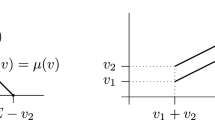Abstract
A Generalized Additive Game (GAG) (Cesari et al. in Int J Game Theory 46(4):919–939, 2017) is a Transferable Utility (TU) game (N, v), where each player in N is provided with an individual value, and the worth v(S) of a coalition \(S \subseteq N\) is obtained as the sum of the individual values of players in another subset \(\mathcal {M}(S)\subseteq N\). Based on conditions on the map \(\mathcal {M}\) (which associates to each coalition S a set of beneficial players \(\mathcal {M}(S)\) not necessarily included in S), in this paper we characterize classes of GAGs that satisfy properties like monotonicity, superadditivity, (total) balancedness, PMAS-admissibility and supermodularity, for all nonnegative vectors of individual values. We also illustrate the application of such conditions on \(\mathcal {M}\) over particular GAGs studied in the literature (e.g., glove games (Shapley and Shubik in Int Econ Rev 10:337–362, 1969), generalized airport games (Norde et al. in Eur J Oper Res 136(3):635–654, 2002), fixed tree games (Bjørndal et al. in Math Methods Oper Res 59(2):249–270, 2004), link-connection games (Moretti in Multi-agent systems and agreement technologies, vol 10767. Springer, Cham, 2008; Nagamochi et al. in Math Oper Res 22(1):146–164, 1997), simple minimum cost spanning tree games (Norde et al. in Eur J Oper Res 154(1):84–97, 2004; Tijs et al. in Eur J Oper Res 175(1):121–134, 2006) and graph coloring games (Deng et al. in Math Program 87(3):441–452, 2000; Hamers et al. in Math Program 145(1–2):509–529, 2014)).

Similar content being viewed by others
References
Aadithya KV, Ravindran B, Michalak TP, Jennings NR (2010) Efficient computation of the Shapley value for centrality in networks. In: International workshop on internet and network economics. Springer, Berlin, pp 1–13
Amer R, Giménez JM (2004) A connectivity game for graphs. Math Methods Oper Res 60(3):453–470
Bilbao JM (2000) Cooperative games on combinatorial structures. Kluwer Academic Publishers, Amsterdam
Bjørndal E, Koster M, Tijs S (2004) Weighted allocation rules for standard fixed tree games. Math Methods Oper Res 59(2):249–270
Bonzon E, Maudet N, Moretti S (2014) Coalitional games for abstract argumentation. In: Proceedings of the 5th international conference on computational models of argument (COMMA’14), p 201
Borm P, Hamers H, Hendrickx R (2001) Operations research games: a survey. Top 9(2):139–199
Brânzei R, Fragnelli V, Tijs S (2002) Tree-connected peer group situations and peer group games. Math Methods Oper Res 55(1):93–106
Branzei R, Moretti S, Norde Tijs S (2004) The P-value for cost sharing in minimum cost spanning tree situations. Theor Decis 56(1–2):47–61
Cesari G, Lucchetti R, Moretti S (2017) Generalized additive games. Int J Game Theory 46(4):919–939
Deng X, Ibaraki T, Nagamochi H, Zang W (2000) Totally balanced combinatorial optimization games. Math Program 87(3):441–452
Hamers H, Miquel S, Norde H (2014) Monotonic stable solutions for minimum coloring games. Math Program 145(1–2):509–529
Hamers H, Horozoglu N, Norde H, Platz T (2019) On totally balanced, submodular and PMAS-admissible weighted minimum colouring games. Working paper
Lindelauf RHA, Hamers HJM, Husslage BGM (2013) Cooperative game theoretic centrality analysis of terrorist networks: The cases of jemaah islamiyah and al qaeda. Eur J Oper Res 229(1):230–238
Littlechild SC, Owen G (1973) A simple expression for the Shapley value in a special case. Manage Sci 20:370–372
Littlechild SC, Thompson GF (1977) Aircraft landing fees: a game theory approach. Bell J Econ 8:186–204
Moretti S (2018) On cooperative connection situations where the players are located at the edges. In: Belardinelli F, Argente E (eds) Multi-agent systems and agreement technologies, vol 10767. EUMAS 2017, AT 2017 Lecture notes in computer science. Springer, Cham
Moretti S, Norde H (2021) A note on weighted multi-glove games. Soc Choice Welf. https://doi.org/10.1007/s00355-021-01337-8
Moretti S, Norde H, Pham Do KH, Tijs S (2002) Connection problems in mountains and monotonic allocation schemes. Top 10(1):83–99
Nagamochi H, Zeng DZ, Kabutoya N, Ibaraki T (1997) Complexity of the minimum base game on matroids. Math Oper Res 22(1):146–164
Norde H, Fragnelli V, García-Jurado I, Patrone F, Tijs S (2002) Balancedness of infrastructure cost games. Eur J Oper Res 136(3):635–654
Norde H, Moretti S, Tijs S (2004) Minimum cost spanning tree games and population monotonic allocation schemes. Eur J Oper Res 154(1):84–97
Okamoto Y (2003) Submodularity of some classes of the combinatorial optimization games. Math Methods Oper Res 58(1):131–139
Schrijver A (2003) Combinatorial optimization. Springer, Berlin
Shapley LS, Shubik M (1969) Pure competition, coalitional power, and fair division. Int Econ Rev 10:337–362
Sprumont Y (1990) Population monotonic allocation schemes for cooperative games with transferable utility. Games Econ Behav 2:378–394
Suri NR, Narahari Y (2008) Determining the top-k nodes in social networks using the Shapley value. In: Proceedings of the 7th international joint conference on autonomous agents and multiagent systems, vol 3, pp 1509–1512
Tijs S, Branzei R, Moretti S, Norde H (2006) Obligation rules for minimum cost spanning tree situations and their monotonicity properties. Eur J Oper Res 175(1):121–134
Wiese H (2004) The outside-option value-axiomatization and application to the gloves game. Mimeo, New York
Wölk ES (1965) A note on “the comparability graph of a tree”. Proc Am Math Soc 16:17–20
Yan J, Chen J, Chang GJ (1996) Quasi-threshold graphs. Discret Appl Math 69:247–255
Acknowledgements
S. Moretti gratefully acknowledges the support of the ANR project THEMIS (ANR-20-CE23-0018).
Author information
Authors and Affiliations
Corresponding author
Additional information
Publisher's Note
Springer Nature remains neutral with regard to jurisdictional claims in published maps and institutional affiliations.
Rights and permissions
About this article
Cite this article
Moretti, S., Norde, H. Some new results on generalized additive games. Int J Game Theory 51, 87–118 (2022). https://doi.org/10.1007/s00182-021-00786-w
Accepted:
Published:
Issue Date:
DOI: https://doi.org/10.1007/s00182-021-00786-w




